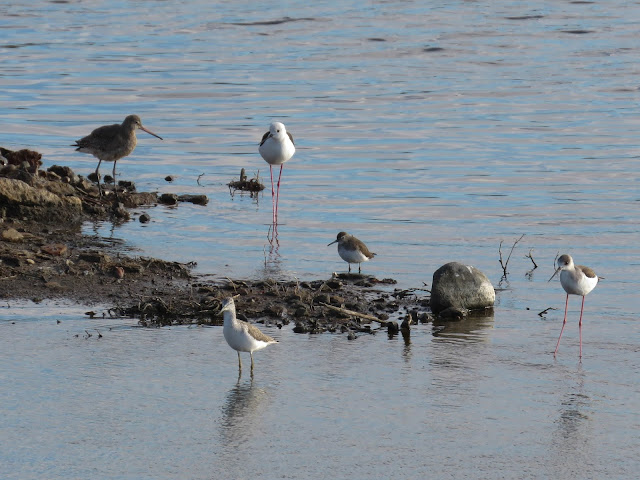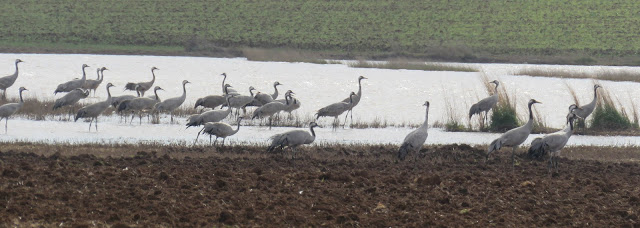 |
| David Elliott-Binns, the man himself with his new T-shirt. Well it made Dave smile! |
Two for the price of one! Looks like Dave and his Arboleas Birding Group have taken to double-day birding and well-rewarded with some very good sightings despite the strong winds. Good to read that the Trumpeter Finches are being easily seen as I shall be up at Cabo de Gata in a fortnight's time. And all being well the weather will have improved with some delightful sunshine but, even better, calmer days!
Sierra de Maria - Wednesday 30th January
I
picked up Paul and Reyna and made our way to the Overa hotel where
Paul and Kath were waiting in their car to follow us to Maria. We
passed the bird count starting point at the garage outside Velez Blanco,
but only saw a Collared Dove before we arrived in Maria. We were joined
by John & Alan, who'd fared better when Alan had spotted a Booted
Eagle.
We decided
to take the loop road from near the La Piza entrance towards the village
of Canada de Canepla and beyond. We saw a large flock of Chaffinch
followed by Carrion Crows, a Raven, and singles of Spotless Starling and Crested Lark. As we approached the village there was a small flock
of Goldfinch. After the village we had small numbers of Calandra Lark and Magpie, but a good flock of Corn Bunting. Also seen were Linnet,
House and Rock Sparrow.
We
back-tracked past the village and turned right onto the loop road. We
stopped by the reed bed, half of which had been destroyed by fire,
whether accidentally or deliberately, I don't know, since Paul and I
were here last week. It will regenerate in time. We did see a Moorhen!
Reyna then spotted some Griffon Vultures, some of which came quite low and close. Also seen were Greenfinch and Red-legged Partridge. I
spotted a Blue Rock Thrush on top of the cliff face. Paul spied a
Kestrel. As we departed Paul found a Black Wheatear and some Sardinian
Warblers. As we were approaching the hamlet from the opposite
direction, we saw a flock of birds in a ploughed field. Mostly White
Wagtails, but at least two Meadow Pipits. Alan had seen a Black
Redstart. At the hamlet we added Thekla Lark. Paul also saw a
Woodpigeon.
 |
| Record shot of Long-tailed Tits Aegithalos caudatus through the bar window (PHOTO: David Elliott-Binns) |
It was
then time to head for La Piza for lunch. I'd bought a supply of peanuts
for the feeders but they were already half-full. We saw all the common
Tits.....Blue, Coal, Crested, Great and Long Tailed. A Great Spotted
Woodpecker came a-calling as did a Jay. After lunch we headed home,
apart from John and Alan who made a quick visit to the chapel area
before the Botanical Gardens. On the way back to Maria we all saw a
small group of low flying Griffon Vultures. Alan and John added Cirl
Bunting, Mistle Thrush and Blackbird to the list.
38 species in all. Thank you to Kath for being scribe for the day. Great company.
Cabo de Gata & Rambla Morales - Thursday 31st January
On
this second consecutive day of birdwatching as requested by my friend,
Paul (Groves). It started with me picking up the other Paul and Reyna
and heading south towards Cabo de Gata. We'd already seen White Wagtail,
House Sparrow, Collared Dove, Black Redstart and Magpie by the time
we'd reached Pujaire. Paul and Neville were already having a coffee in
the cafe as we, and Peter and Alec, arrived. As forecasted, there was
high winds, but are we fair weather birders? Never! We headed for the
first hide. There were as usual plenty of Greater Flamingos. A Little
Egret was to our left and 5 Black-tailed Godwits were feeding in front
of the hide. Another small flock joined them. Three small birds flew
past with a slightly pinky beige colouring. Trumpeter Finches. I spotted
an Iberian Grey Shrike perched just beyond the right hand stone wall.
Paul (G) then spotted an Eurasian Curlew walking near to the water line
in front of us. I found a Water Pipit walking on the yellow floating
weeds to the left.
We drove round to the
beach across from the second hide. High winds meant large waves. We
sea-watched for a bit without success. A Lesser Black-backed Gull flew
over as we walked towards the hide. Knowing where the Spoonbills had
previously been seen, I checked the small island opposite and sure
enough half a dozen or more were there. as was some Yellow-legged Gulls.
Paul (G) found a Redshank and Mallard. A male Stonechat showed well
atop a shrub in front of us. A pair of Greenfinch perched briefly to our
right. We tacked back to the vehicles and seeked the shelter of the
enclosed public hide. In front of it was a line of mostly Lesser Black-backed Gulls, but there were also half a dozen Audouin's Gulls. Later
Paul noticed two Mediterranean Gulls had joined them. A Sardinian
Warbler flew past.
There were small flocks of Shelduck on the water and
I spotted a couple of Cormorant on the far left causeway. Paul (G)
checked out the waders to the right and found small numbers of
Sanderling, Dunlin, Avocet and Black-winged Stilt. I found a distant
Greenshank. We left the area using the track to the church, seeing the
odd Stonechat on the way. As we waited for the others to catch up we saw
an adult Gannet fly by quite close to the shore. We drove back along
the beach road, stopping once to check out a Meadow Pipit.
 |
| Mediterranean Gull Larus melanocephalus (PHOTO: David Elliott-Binns) |
The
wind speed had increased as we drove along the beach-side track towards
the Rambla Morales. We added Thekla Lark and Corn Bunting en route.
The wind pushed us towards the "hump". Once up there a quick scan
produced Coot, Shoveler and about a dozen White-headed Ducks. I spotted a
raft of 20 Wigeon, a good record here. We struggled back to the cars
against the wind and getting sand-blasted as well. We headed for the
warmth and shelter of the pasteleria opposite the new BP petrol
station. Through the window we added Spotless Starling and Kestrel to
complete the list.
39 species in total. The winter cobwebs have definitely been blown away!
Regards,
Dave
It
is with great sadness that I have to inform you, Ann Smith, wife of
Trevor, passed away on Monday. I'm sure you'll join me in expressing our
sincere condolences to Trevor and the rest of the family.
Check out the accompanying website at http://www.birdingaxarquia.weebly.com for the latest sightings, photographs and additional information




















































